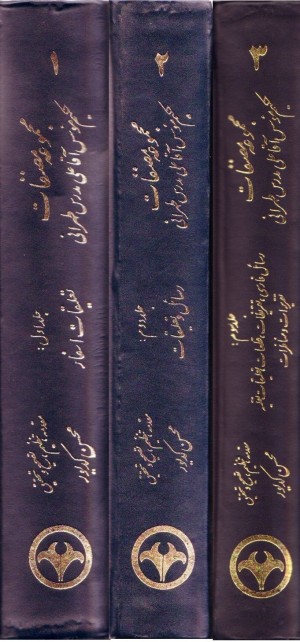
The Compilation of the Works of the Sage & Originator
Agha Ali Mudarris Tehrani
(Majmu’eyeh mossnafateh hakimeh mo’assess Agha Ali Modarres Tehrani)Three Volumes, 1937 pages
Introduction, Compilation, prolegomenon, and Research Notes By
Mohsen KadivarTehran, Ettela’t Publications, 1999
Vol. I. “Ta’alighaat-e Asfaar,” Commentaries on the Asfaar of Mullah Sadra, 872 pages, ISBN 944-423-413-8
Vol. II. “Rassaa’el Arabi va Ta’aliqat-e Falsafi,” Treaties and Commentaries, 578 pages, ISBN 944-423-414-6
Vol. III. “Rasa’el Farsi, Taqrizat. Qate’aat, Ta’aliqat Naqlieh, Taqrirat va Monazerat,” (Persian Treaties, Forewords, Pieces, Narratives, Commentaries, Discourses and Debates, 570 pages. ISBN 964-423-416-2
Agha Ali Mudarris Tehran (1234-1307 Hejira, 19th century AD) was the son of Mola Abdullah Mudarris Zonoozi, one of the most dexterous Islamic scholars and most skilful in interpreting the works of Mola Sadra. Although most Islamic scholars would focus their attempts on transcendental philosophy, Agha Ali’s most significance that won him the title Hakim Mu’assis comes from his work on the principles and presentation of new readings from Sadray’i principles, his wise critique on the views of Mula Sadra, and his proposal of new ideas in several philosophical debates.
His innovative views on physical resurrection and the Hereafter, the credits of the essence, predication, the existence of relationship, knowledge, secondary philosophical debates, essential motion and its case, predicates in the subject of knowledge, the principality of existence, expansionism, the analogicity of existence, the self and its superiors’ being pure existence, the existential unity of accidents with subjects, the totality of the world, the motion of the soul in the Hereafter, the unity of the ascending and descending curves, etc are merely evidential of his wisdom. Mudarris Tehrani’s most outstanding work was Badayi’ al-Hikam which is one of the most authentic works of theological philosophy and one of the most invaluable works of philosophy in Farsi.
Despite the importance of the views of the Originator, many of his works were unknown. Secondly, most his works were manuscripts and thus unpublished. Thirdly, the works published over a century ago were rare. During a period of four years of research and study, over 30 works of Agha Ali were identified and all the existing works were compiled, corrected, and researched based on all of the manuscripts and old publications and finally published with an analytical introduction and different indices. Badayi’ al-Hikam is the fourth volume of this collection.
The analytical introduction of this collection discusses the development of Islamic philosophy from the beginning up to the 19th century AD, the biography of Agha Ali Mudarris Tehrani, the publications of the Originator, and finally the specifications of the Originator’s collection of works.
Volume 1: Assfar Commentaries
Assfar Commentaries is Mudarris Tehrani’s most extended work. These commentaries are one of the most important annotated books and contain some of the most brilliant innovations of the Originator. Agha Ali has allocated a substantial amount of these commentaries to the critical analysis of the annotations of Haj Mula Hadi Sabzevari and Mula Ahmad Ardakani. In addition, he has discussed and reviewed the ideas of other philosophers including those of his own teachers.
This volume includes 1720 commentaries of the four Assfar based on 14 manuscripts which have been compiled, corrected, and researched. Commentaries of the section of substances and accidents are extremely few. Except for a few commentaries of The Journey of Self (Safar-i Nafs), almost all of these commentaries are being published for the very first time.
Volume 2: Treatises and Commentaries (Rassayel va talighat)
This volume comprises four Arabic treatises and 10 philosophical commentaries of Agha Ali’s. Ressalato fi tohid, Ressalato sabilo reshad fi essbat elma’ad, ressalato fi mabahess olhaml, and Ressalato felvojood olrabet are among the most significant philosophical writings of Tehrani. They could each in their own topics even be considered as the last achievement of Islamic philosophy.
The four issues of monotheism, physical resurrection and the Hereafter, predication, and the existence of a copula have been discussed from a new angle in these treatises. The last three treatises, in particular, are filled with Agha Ali’s innovative views. His most important innovation on physical resurrection has been expounded upon in Ressalato sabilo reshad fi essbat elma’ad. The rest of this volume comprises a commentary on four other works of Mola Sadra and a commentary on the first volume of Shavaregholelham. The introduction discusses in detail the content and the manuscript of each work.
Volume 3: Farsi Treatises, Forewords, Pieces, Narrated Commentaries, Writings, and Debates
14 other works of Agha Ali have been compiled in this volume in five sections. Four Farsi treatises Ressalato fi ahkam elvojood va almahiya, Ressalato haghighato Muhammediyah, Treatise on the Autobiography of Hakims, and Treatise on History make up the most major works in this volume.
Agha Ali’s last work, ie the unfinished introduction on Kashf olassrar fi sharheh assrar olayat, remaining pieces from the important yet lost work Ossool olhekam fi sharheh othologia, the remainder of his poems and lyrics, a commentary on a treatise of Mirza Hassan Ashtiani (his teacher) about the regulations of fiqh are also included in this volume. Half of the third volume is the forewords of Molasadra’s Almabda va almaad which have been transcribed from Agha Ali’s classes by one of Agha Ali’s students. The concluding part of this collection is Agha Ali’s debate with Karim Khan Kermani. The introduction discusses the specifications of the manuscripts and their attribution to Agha Ali together with a content analysis of every work.

